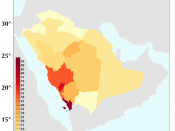From the Systat data file for WDI2003 data related to several variables concerning global development and related fields have been complied and give code names. The code FERAT is a representation of the ratio of women age 65 and above per 100 men in the same age group. FERAT80 and FERAT01 are the same variable but represent data collected in two different years. FERAT80 is data corresponding to statistics collected worldwide in the year 1980, and FERAT01 is the data collected in the year of 2001.
The variable FERAT was chosen to explorer the ration of elderly women to elderly men, and to pursue interest of areas pertaining to the persons in the geriatric phases of life. It was assumed by the observer that the data would reveal that most countries represented by the statistics would either remain relatively close in numbers between the two periods of data collection or the ratio of female per 100 males of the defined age group would increase because of overall life expectancy increases.
It was also expected that some countries would show a decrease of the number of women per 100 men.
To explore the data obtained from the World's Bank's World development indicators this paper will discuss the statists found on descriptive charts, stem-leaf diagrams, box-and-whisker plots and a scatterplot. Outlier countries will be examined for possible explanations for the deviance from the quartiles.
Descriptive Basic StatisticsIn the chart below there are 131 reporting countries for the year of 1980, but in 2001 there are 132 countries reporting data for this variable. It was found that the country of West Bank did not report data for the 1980 year. West Bank is also known as Judea and Samaria, and is located geographically "in a landlocked position on the west bank of the...


